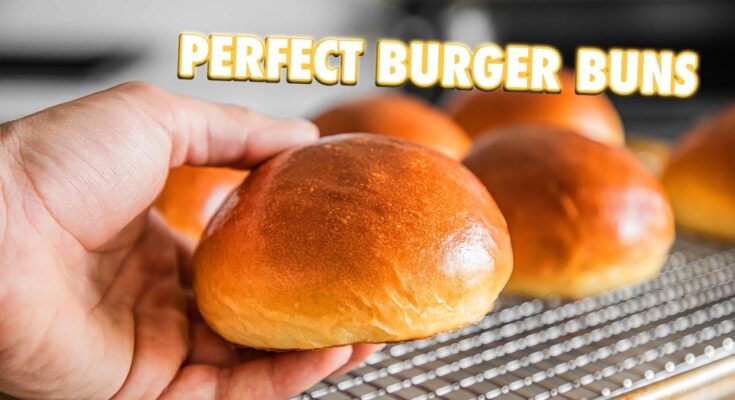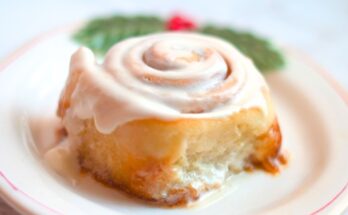Hamburger Buns Recipe: Let’s be honest: nothing beats the aroma and taste of freshly baked hamburger buns straight from your own oven. Store-bought buns might be convenient, but they often fall short in texture, flavor, and that fluffy interior every burger deserves. Making them at home gives you full control over what goes in them—no unnecessary preservatives, no additives, just pure ingredients that elevate your burgers to gourmet status. Plus, there’s a sense of pride and satisfaction in saying, “I made these from scratch!”
Homemade buns are also incredibly versatile. You can adjust the size depending on the type of burger you’re serving—slider-sized for parties or larger for double-stacked creations. Want sesame seeds? Go ahead. Prefer them slightly sweet? Add a touch more sugar. It’s this customization that turns your basic hamburger into a personalized culinary masterpiece.
But perhaps the biggest reason to go homemade? They’re deceptively simple. With just a few pantry staples and some patience, you’ll whip up golden, pillowy buns that will make any burger (or sandwich) taste like a restaurant-quality meal.
What Makes a Perfect Hamburger Bun?
The ideal hamburger bun should be soft but sturdy. You want it to hold the juiciest patties and toppings without falling apart or turning soggy. The texture should be light and airy inside, with a slightly chewy crust outside. A good bun complements the flavors of your burger without overpowering them.
Color is another hallmark. A glossy, golden-brown top—often achieved with an egg wash—isn’t just eye-catching; it adds a subtle richness to the taste. Toppings like sesame seeds or even poppy seeds add that gourmet flair. The bun should be slightly sweet, with a subtle buttery aroma, giving it that melt-in-your-mouth quality.
Lastly, consistency is key. Uniform size ensures even baking, and proper rising techniques ensure that signature fluffy texture. Once you nail this, your burgers will never be the same.
Ingredients Needed for Soft and Fluffy Buns
Key Ingredients Breakdown
To create the best hamburger buns, you’ll need some baking basics:
- All-purpose flour (3½ cups): The foundation. You can mix with bread flour for extra chewiness.
- Warm milk (1 cup): Adds richness and helps keep buns soft.
- Granulated sugar (2 tablespoons): Feeds the yeast and sweetens the dough slightly.
- Active dry yeast (1 tablespoon): Makes the dough rise and become airy.
- Butter (2½ tablespoons, melted): Adds flavor and tenderness.
- Salt (1½ teaspoons): Balances flavor and strengthens the dough structure.
- Egg (1): Enhances texture and color; used in the dough and for brushing tops.
Optional but helpful:
- Sesame seeds: For a classic touch.
- Honey: Substitute some sugar with honey for deeper sweetness.
These ingredients are often already in your pantry, and they come together beautifully to create the perfect dough.
Optional Add-ins and Toppings
Once you’ve mastered the basic dough, get creative. Mix in herbs like rosemary or thyme for a savory twist. Want a touch of sweetness? Add a spoon of honey or a dash of cinnamon.
For the top, sesame seeds are classic, but don’t stop there. Try:
- Everything bagel seasoning
- Poppy seeds
- Sea salt flakes
- A light brush of butter after baking for extra shine
Remember: toppings should complement the filling of your burger, not compete with it.
Equipment You’ll Need
Kitchen Tools Checklist
You don’t need a professional kitchen setup, but a few key tools make the job easier and more efficient:
- Large mixing bowl: For combining ingredients.
- Measuring cups and spoons: Accuracy is crucial in baking.
- Stand mixer with dough hook (optional): Saves time and effort on kneading.
- Baking sheet or tray: Line it with parchment paper for easy cleanup.
- Plastic wrap or a clean towel: To cover dough during proofing.
- Pastry brush: For applying egg wash or butter.
- Cooling rack: Prevents sogginess by allowing airflow around baked buns.
Having everything prepped ahead of time streamlines the process and avoids last-minute scrambling. Now that you’re armed with ingredients and tools, let’s dive into the fun part: baking!
Step-by-Step Instructions to Make Hamburger Buns
Step 1 – Activating the Yeast
This is the foundation of any good bread recipe. Yeast needs warmth and food (sugar) to activate. Here’s how to do it right:
- Warm your milk to about 100–110°F (lukewarm, not hot).
- In a small bowl, mix the milk with 1 tablespoon of sugar.
- Sprinkle the yeast on top, stir gently, and let it sit for 5–10 minutes.
You’ll know it’s working when it gets frothy on top. If it doesn’t foam, your yeast might be expired—start over to ensure fluffy buns.
This small step might seem basic, but it’s make-or-break for the rest of your dough. Active, bubbling yeast guarantees rise, texture, and structure. Without it, your buns will fall flat—literally.
Step 2 – Mixing the Dough
Once your yeast is activated and frothy, it’s time to bring the dough together.
In a large mixing bowl (or stand mixer if you have one), combine the flour and salt. Make a well in the center and pour in the yeast mixture, melted butter, and a beaten egg. Use a wooden spoon or dough hook to slowly incorporate the ingredients.
At first, the dough might seem sticky—and that’s okay. Continue mixing until it starts to pull away from the sides of the bowl. If it’s too wet, sprinkle in more flour, one tablespoon at a time. Resist the urge to over-flour, though. A slightly sticky dough yields softer buns.
Once the dough comes together, it should be soft, slightly tacky but not clinging to your fingers. This stage sets the base for fluffy buns, so take your time to get it right. Mixing until just combined ensures the dough isn’t overworked, which could make the buns dense.
Step 3 – Kneading the Dough
Now the real magic begins—kneading. Whether by hand or mixer, kneading develops gluten, the protein structure that gives buns their chew and elasticity.
If you’re kneading by hand:
- Lightly flour a clean surface.
- Turn out the dough and push it away from you using the heel of your palm.
- Fold it back, rotate it slightly, and repeat for about 8–10 minutes.
If using a stand mixer:
- Attach the dough hook and knead on medium speed for 6–7 minutes.
The dough is ready when it’s smooth, elastic, and springs back when poked. You can do the “windowpane test” by stretching a small piece between your fingers. If it forms a thin, translucent membrane without tearing, you’re good to go.
Kneading is therapeutic—turn on some music, get into a rhythm, and let the dough relax with you. The more love you give here, the better the buns turn out.
Step 4 – First Rise
Once kneaded, it’s time to let the dough rest and rise—this is called “proofing.”
- Lightly oil a large bowl.
- Place your dough inside, turning once so it’s coated.
- Cover with plastic wrap or a clean kitchen towel.
- Let it rise in a warm, draft-free place for 1–1.5 hours, or until it has doubled in size.
This resting period allows the yeast to do its job—creating air pockets that result in soft, fluffy buns. If your kitchen is cool, you can place the bowl in a turned-off oven with the light on or near a sunny window.
Patience is key here. Don’t rush this step. Letting the dough double ensures better structure and flavor. You’ll know it’s ready when you gently press a finger into the dough and the indentation remains.
Step 5 – Shaping the Buns
Once your dough has risen, it’s time to shape your buns. This is where your buns get their final look, so precision helps.
- Punch down the dough to release air.
- Turn it onto a floured surface and divide it into 8 equal pieces (or 10 if you want smaller buns).
- Take each piece and form a ball by tucking the edges underneath and pinching them together.
- Roll gently between your palms to create a smooth, even sphere.
Place the balls on a parchment-lined baking sheet, spacing them a few inches apart to allow for rising and baking.
For flatter buns (great for burgers), gently press the tops to flatten slightly. For more dome-like buns (perfect for sandwiches), leave them as balls.
Cover them again with a kitchen towel and let them rise for another 30–45 minutes. They should puff up nicely, almost doubling again.
At this point, you’re close to the finish line. The buns are shaped, risen, and nearly ready for their golden-brown transformation.
Step 6 – Second Rise
This second rise is essential for achieving that perfect light and airy texture. After shaping the dough into buns and placing them on a parchment-lined baking sheet, cover them loosely with a clean kitchen towel. Let them rest and rise for about 30 to 45 minutes at room temperature.
You’ll notice the buns becoming puffier, expanding in size gently. This step ensures they bake evenly and develop that delicate interior structure you want in a hamburger bun. Don’t skip or rush this stage—it’s the final opportunity for the yeast to do its job before hitting the oven.
If you want a glossy finish, now’s the time to prepare your egg wash. Beat one egg with a tablespoon of water and gently brush the tops of the risen buns. This not only gives them a beautiful golden sheen but also acts as a glue if you’re adding sesame seeds or other toppings. Be gentle—too much pressure could deflate them.
Step 7 – Baking the Buns
Now for the most exciting part—baking your buns to golden perfection.
Preheat your oven to 375°F (190°C). Place the tray of buns on the center rack and bake for 15–18 minutes, or until the tops are deep golden brown. Keep a close eye on them in the last few minutes to avoid over-baking. Every oven varies slightly, and color is the best indicator.
Once they’re out, transfer them immediately to a cooling rack. This step prevents the bottoms from becoming soggy. Let them cool for at least 15–20 minutes before slicing—if you can wait that long! Cutting them while too hot can tear the soft interior and let steam escape, drying them out.
At this stage, your kitchen smells like a bakery, and your golden, fluffy buns are ready to elevate any burger you can dream of. Whether you’re building a classic cheeseburger or a veggie-packed stack, these buns are the base that makes everything better.
Tips for Perfect Hamburger Buns
Avoid These Common Mistakes
Even though this recipe is beginner-friendly, a few common mistakes can make or break your buns. Let’s tackle them so your efforts pay off:
- Using water that’s too hot for yeast: If your milk or water is over 115°F, it can kill the yeast. Always check it’s warm—not scalding.
- Not kneading enough: Under-kneading leads to flat, dense buns. Make sure your dough is elastic and passes the windowpane test.
- Over-flouring the dough: It’s tempting to keep adding flour to avoid stickiness, but too much will make your buns heavy. The dough should be slightly sticky but manageable.
- Skipping rises or rushing proofing time: Patience is crucial. Letting the dough rise fully at each stage gives your buns structure and airiness.
- Over-baking: This dries them out. Remove them as soon as the tops turn golden brown and sound hollow when tapped.
- Not cooling properly: Always cool your buns on a rack to prevent a soggy bottom. It’s worth the wait.
Bonus tip: Brushing your buns with butter right after baking adds a rich flavor and softens the crust. It’s the secret touch that makes your buns bakery-worthy.
Storing and Freezing Buns
Best Storage Practices
Once your hamburger buns are baked and cooled, proper storage is essential to keep them fresh and fluffy. Homemade buns lack preservatives, so they’ll start to dry out after a couple of days if not stored correctly.
Here’s how to store them to keep that fresh-from-the-oven taste:
- Short-Term Storage (2–3 days): Place your completely cooled buns in an airtight container or resealable plastic bag. Store them at room temperature in a cool, dry place. Avoid refrigerating them as the cold can make them go stale faster.
- Re-softening Tip: If your buns start to get slightly stale, just wrap them in a damp paper towel and microwave for 10–15 seconds. It’ll bring back the softness instantly.
You can also toast the insides slightly on a pan before building your burger for that perfect combination of crispy and fluffy.
How to Freeze and Reheat
Want to make a big batch and save some for later? Freezing is the way to go—and it works beautifully with these homemade buns.
Here’s a step-by-step freezing guide:
- Cool the buns completely. This is crucial. Warm buns will create condensation in the bag, leading to freezer burn.
- Wrap each bun individually in plastic wrap or aluminum foil. This helps maintain freshness and prevents them from sticking together.
- Place the wrapped buns in a zip-top freezer bag and squeeze out as much air as possible before sealing.
They’ll keep well in the freezer for up to 3 months.
Reheating Instructions:
- To thaw: Take out the desired number of buns and leave them at room temperature for 1–2 hours.
- For quicker results: Microwave a frozen bun (unwrapped) on a plate covered with a damp paper towel for 30–45 seconds.
- For extra flavor: Slice and toast lightly on a skillet or in the oven at 350°F (175°C) for 5–7 minutes.
Freezing and reheating make it incredibly convenient to always have homemade hamburger buns ready for your next burger night, picnic, or backyard barbecue.
FAQs about Hamburger Buns Recipe
1. Can I make hamburger buns without yeast?
Yes, you can make hamburger buns without yeast by using baking powder or baking soda as a leavening agent. However, the texture will be more biscuit-like and less fluffy compared to yeast-risen buns.
2. How long do homemade hamburger buns last?
Homemade hamburger buns typically stay fresh for 2–3 days at room temperature. Store them in an airtight container or wrap them in plastic to keep them soft. For longer storage, freeze them for up to 3 months.
3. Can I freeze hamburger buns?
Absolutely! Once the buns have completely cooled, place them in a zip-top freezer bag and freeze. Thaw at room temperature or warm in the oven for best results.
4. Why are my buns too dense?
Dense buns often result from insufficient kneading, not allowing enough time for the dough to rise, or using too much flour. Make sure to follow the rising times closely and avoid overworking the dough.
5. Can I use all-purpose flour instead of bread flour?
Yes, you can use all-purpose flour, but bread flour typically yields lighter and chewier buns due to its higher protein content. If you want fluffier results, consider adding a tablespoon of vital wheat gluten when using all-purpose flour.
6. How do I get a shiny top on my buns?
Brush the buns with an egg wash (a mix of beaten egg and a tablespoon of water) before baking. This gives them that classic golden, glossy finish.
7. What toppings can I sprinkle on the buns before baking?
Common toppings include sesame seeds, poppy seeds, everything bagel seasoning, or even a light sprinkle of sea salt. Brush with egg wash first to help the toppings stick.
8. Can I make mini or slider buns with this recipe?
Yes! Simply divide the dough into smaller portions and reduce the baking time slightly. Keep an eye on the oven to prevent overbaking.
9. Why do my buns spread out too much during baking?
This might be due to over-proofing the dough or using too little flour. Chill the dough briefly before shaping to help maintain structure, and avoid letting the dough rise too long.
10. Are these buns suitable for vegan diets?
You can easily make vegan hamburger buns by replacing dairy milk with plant-based milk and using vegan butter or oil. Omit the egg wash or use a plant-based milk wash for browning.
Conclusion
Making homemade hamburger buns from scratch isn’t just about saving a trip to the store—it’s about elevating your meals with soft, golden, flavor-packed buns that take your burgers from basic to next-level. With simple ingredients, a bit of kneading, and some patience, you’ll create buns that are fluffy, slightly sweet, and wonderfully sturdy.
This step-by-step guide walks you through every detail—from activating the yeast to shaping, baking, and storing—so your kitchen turns into a mini bakery. And once you’ve tasted a burger on your very own homemade bun, you’ll never want to go back to store-bought again.
Whether you’re a weekend griller or a meal-prep master, these buns will become a staple in your kitchen. Try the recipe, tweak it to your liking, and make every bite count.



